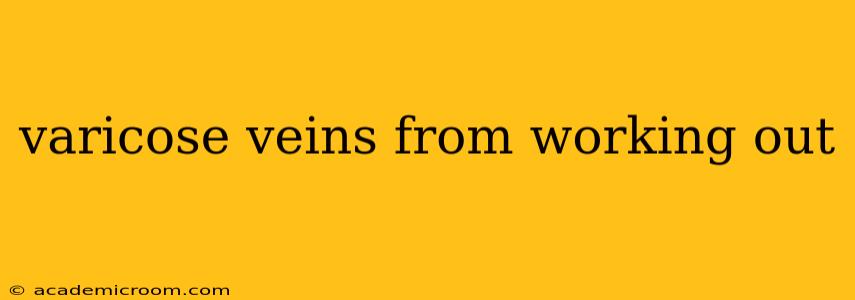Varicose veins, those unsightly, bulging veins often appearing on the legs, are a common concern. While many associate them with age and genetics, some wonder if strenuous exercise could contribute to their development. This article delves into the relationship between working out and varicose veins, separating fact from fiction and providing you with the information you need to make informed decisions about your health and fitness routine.
Can Working Out Cause Varicose Veins?
The short answer is: not directly. Working out itself doesn't cause varicose veins. However, the increased pressure on your leg veins during intense or prolonged exercise can exacerbate existing conditions or potentially accelerate their development in individuals who are already predisposed. Let's explore this further.
Varicose veins arise from weakened or damaged valves within the veins. These valves typically prevent blood from flowing backward, but when they malfunction, blood pools, causing the veins to swell and become visible. Several factors contribute to this valve damage, including genetics, age, prolonged standing or sitting, pregnancy, and obesity.
Intense physical activity, particularly high-impact exercises or those involving prolonged standing or straining, can increase the pressure within the leg veins. This increased pressure puts additional stress on the already weakened valves, potentially worsening the condition or speeding up its progression in susceptible individuals.
What Types of Exercise Might Increase Varicose Vein Risk?
While all forms of exercise offer numerous health benefits, some may pose a slightly higher risk for individuals prone to varicose veins:
- High-impact activities: Running, jumping, and other high-impact exercises can significantly increase pressure on the leg veins.
- Prolonged standing: Occupations or activities requiring prolonged periods of standing, like teaching or nursing, can contribute to varicose vein development. Similarly, long periods of standing during workouts, such as holding certain yoga poses, could also be a contributing factor.
- Weightlifting: Heavy weightlifting, especially leg presses, can also increase venous pressure in the legs.
Are There Exercises That Are Better for People With Varicose Veins?
Absolutely! Low-impact exercises are generally recommended for individuals with varicose veins or those at risk. These activities put less strain on the legs and reduce the pressure on the veins. Examples include:
- Swimming: The buoyancy of the water supports your body, minimizing stress on the legs.
- Cycling: Cycling is a low-impact exercise that promotes blood circulation without excessive pressure on the veins.
- Walking: Moderate walking is beneficial for overall health and can improve circulation, but avoid prolonged periods of standing still during walks.
Can I Prevent Varicose Veins With Exercise?
While exercise itself won't prevent varicose veins in individuals genetically predisposed, maintaining a healthy weight through regular exercise can help. Obesity puts extra strain on the circulatory system, including the leg veins, increasing the risk of developing varicose veins. Moreover, regular exercise promotes healthy blood circulation, which can help manage existing varicose veins and improve overall vein health.
How Can I Tell If My Exercise Routine Is Contributing to My Varicose Veins?
If you notice a worsening of your varicose veins after specific workouts or activities, it's a good idea to adjust your routine. Pay attention to any increase in pain, swelling, or discomfort in your legs. If you experience significant changes or increased symptoms, it's crucial to consult a healthcare professional.
What are the Symptoms of Varicose Veins?
Common symptoms of varicose veins include:
- Visible bulging veins: These are often dark purple or blue in color.
- Aching or heavy feeling in the legs: This feeling is often worse after prolonged periods of standing or sitting.
- Leg swelling: Swelling is a common symptom, particularly at the end of the day.
- Skin changes: In some cases, varicose veins can lead to skin discoloration or changes in skin texture.
Remember, this information is for general knowledge and doesn't constitute medical advice. Always consult with a doctor or healthcare professional for personalized advice regarding your health and exercise routine, especially if you have a history of varicose veins or experience any concerning symptoms. They can help you determine the best course of action for your specific situation.
